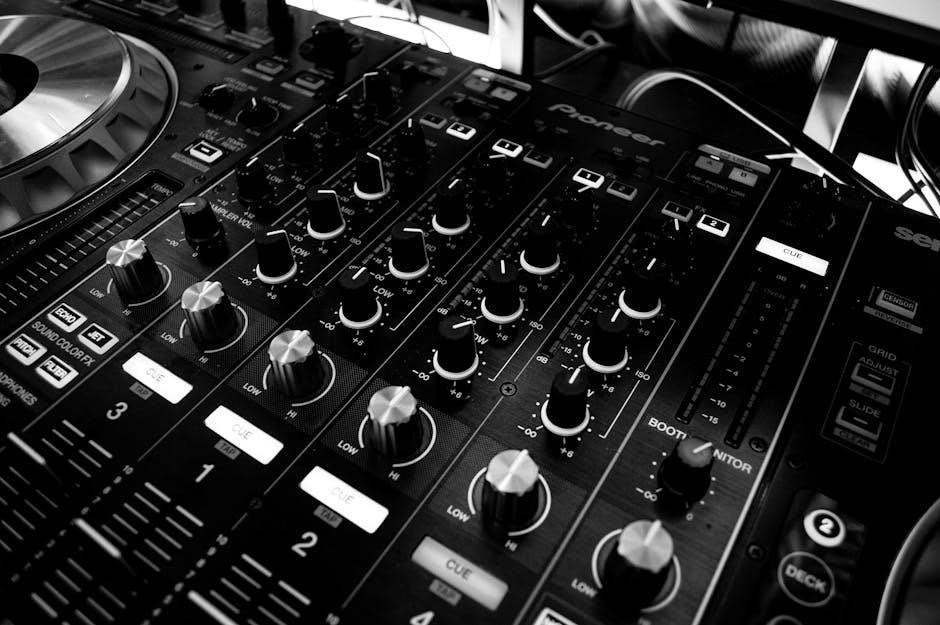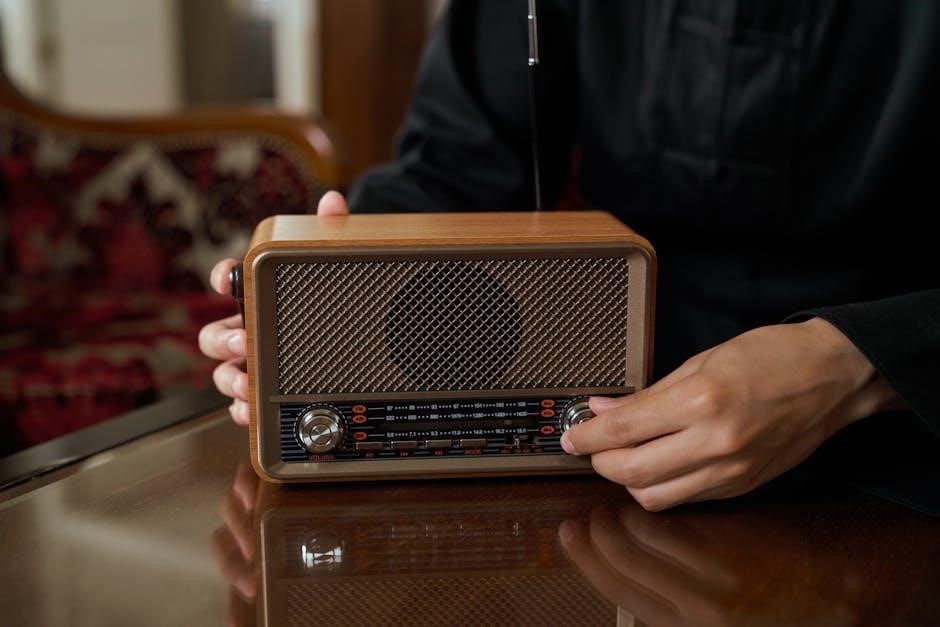An EQ Frequency Guide is a tool for understanding and manipulating audio signals by boosting or cutting specific frequencies to achieve balance and clarity in sound.
The Audio Frequency Spectrum
The audio frequency spectrum spans from 20Hz to 20kHz, representing the range of human hearing, and is divided into sub-bands for equalization purposes.
2.1 Low-Frequency Ranges (20Hz ─ 250Hz)
The low-frequency range, spanning from 20Hz to 250Hz, is crucial for adding depth and warmth to audio. Frequencies below 60Hz contribute to the sub-bass and bass, providing the foundational rumble and weight in music. Between 60Hz and 250Hz lies the bass range, which adds body and fullness to sounds, particularly in instruments like the kick drum and bass guitar. Boosting around 100Hz can enhance the lower-end warmth, while cutting excess around 200-250Hz can reduce muddiness. Properly balancing these frequencies ensures a clear and impactful low-end without overwhelming the mix. This range is essential for creating a solid sonic foundation in any audio production or mixing process.
2.2 Mid-Frequency Ranges (250Hz ─ 2000Hz)
The mid-frequency range, spanning from 250Hz to 2000Hz, is vital for clarity and presence in audio. Frequencies between 250Hz and 500Hz often contribute to warmth and body, while excessive buildup in this range can create muddiness. Boosting around 500Hz to 800Hz can enhance vocal and instrumental clarity, making sounds more intelligible. The upper midrange (1kHz to 2000Hz) adds presence and definition, particularly in vocals and guitars. Cutting in this range can reduce harshness, while boosting can add brightness. Balancing the midrange is crucial for achieving a natural and balanced sound, as it heavily influences how instruments and vocals sit in the mix. Proper EQ adjustments in this range ensure that elements are neither lost nor overpowering.

2.3 High-Frequency Ranges (2000Hz ⎼ 20kHz)
The high-frequency range, spanning from 2000Hz to 20kHz, is crucial for clarity, detail, and brightness in audio. Frequencies between 2kHz and 5kHz enhance presence and definition, especially in vocals and instruments like guitars. Boosting in this range can add clarity, while excessive levels may introduce harshness. Above 5kHz, frequencies contribute to airiness and sparkle, with 10kHz to 20kHz often used to add a sense of space and openness. However, overboosting can make the sound brittle or fatiguing. High frequencies are also genre-dependent, with genres like electronic music often requiring more emphasis in this range. Proper adjustments ensure that high frequencies enhance the mix without overpowering it, balancing detail and smoothness for a polished sound. This range is vital for creating a natural and engaging listening experience.

Common EQ Techniques
Common EQ techniques include boosting to enhance desired frequencies and cutting to remove unwanted tones. Understanding the Q factor and frequency ranges is essential for effective EQing.
3.1 Boosting and Cutting Frequencies
Boosting and cutting frequencies are fundamental EQ techniques used to enhance or attenuate specific audio ranges. Boosting increases the volume of a selected frequency, adding brightness, warmth, or presence. Cutting reduces the volume, eliminating muddiness or harshness. For example, boosting around 3-5kHz can add clarity to vocals, while cutting 200-300Hz can reduce muddiness in basslines. These adjustments help balance the mix, ensuring each element occupies its rightful space. Proper use requires a good ear and understanding of where instruments naturally sit in the frequency spectrum. Overboosting or overcutting can lead to an unbalanced sound, so subtle adjustments are often key to achieving a polished mix.
3.2 Understanding the Q Factor

The Q factor determines the width of the frequency range affected by an EQ boost or cut. A high Q value results in a narrow, precise adjustment, useful for targeting specific issues like resonances; A low Q value broadens the range, affecting a wider band of frequencies. For example, a narrow Q can isolate a problematic mid-frequency in a vocal, while a wide Q can enhance the overall brightness of a mix. Balancing Q and gain ensures natural-sounding adjustments without overprocessing. Mastering the Q factor enhances control over tonal shaping, allowing for precise or subtle changes depending on the situation. This versatility makes it a critical parameter in achieving desired audio outcomes effectively.
EQ for Instruments and Vocals

EQ optimizes the tone of instruments and vocals by targeting specific frequency ranges to enhance clarity, balance, and presence in a mix, ensuring each sound shines naturally.
4.1 EQ Frequency Ranges for Common Instruments
Understanding EQ frequency ranges for common instruments is crucial for a balanced mix. The kick drum typically sits between 50-100 Hz, providing punch and low-end weight. The snare drum often resides in the 100-300 Hz range, contributing to its body and snap. Bass guitars are usually found in the 50-250 Hz range, delivering warmth without muddiness. Electric guitars occupy the 200-800 Hz range for clarity and definition. Pianos span a wide range, with their body in the 250-3000 Hz range and attack in the 5000-6000 Hz range. Vocals generally lie between 250-8000 Hz, with key frequencies like presence at 3-5 kHz and air at 10 kHz and above. By targeting these ranges, mix engineers can enhance each instrument’s unique characteristics and ensure a cohesive sound. Proper EQ ensures instruments occupy their rightful space in the mix, avoiding clashes and promoting clarity.

4.2 Vocal Frequency Ranges and Adjustments
Vocal frequencies typically range between 250 Hz and 8000 Hz, with key adjustments depending on the singer’s tone. Soprano vocals often lie in the 250-1300 Hz range, while alto and tenor voices are found in 180-700 Hz and 130-500 Hz, respectively. Baritone voices generally occupy 100-400 Hz. To enhance clarity, boost frequencies around 3-5 kHz for presence. Cutting between 200-300 Hz can reduce muddiness. For brightness, add a high shelf above 10 kHz. These adjustments help vocals stand out in a mix while maintaining natural tone. Proper EQ ensures vocals are clear and well-balanced, making them the focal point of a track. Understanding these ranges allows engineers to tailor adjustments for optimal vocal performance.

Practical Applications of EQ
Equalization is a powerful tool used across music genres to enhance sound quality. It helps in boosting bass for dance tracks and adding clarity in hip-hop vocals. EQ adjustments can fix common issues like muddiness in the low end and harshness in the high frequencies, ensuring a balanced mix.
5.1 Using EQ for Different Music Genres

Equalization techniques vary significantly across music genres, as each style emphasizes specific frequency ranges. For instance, hip-hop and electronic dance music (EDM) often focus on enhancing low-end frequencies (50-100 Hz) to create a powerful bassline, while cutting midrange frequencies (200-500 Hz) to avoid muddiness. In contrast, rock and pop music benefit from boosting high frequencies (5k-10kHz) to add clarity and brightness to cymbals and vocals. Jazz and classical music prioritize midrange clarity (1k-3kHz) to highlight instrumental details. Understanding these genre-specific EQ approaches allows producers to tailor their mixes effectively, ensuring each element sits well within the audio spectrum. This targeted use of EQ ensures a balanced and genre-appropriate sound, enhancing the overall listening experience for fans of each style.
5;2 Fixing Common Frequency Issues
Addressing frequency issues is crucial for a polished mix. Low-end rumble (below 80 Hz) can be eliminated by high-pass filtering or cutting these frequencies. Muddiness in the 200-500 Hz range often results from overlapping bass and midrange elements, requiring precise cuts. Harsh high frequencies (5k-10kHz) can be tamed with gentle cuts. Sibilance in vocals (5k-8kHz) is reduced using de-essers or narrow notches. Boosting midrange (1k-3kHz) adds clarity to instruments and vocals. These adjustments ensure a balanced and clear mix, resolving common frequency problems effectively. Proper EQ techniques help create a professional-sounding track, enhancing overall audio quality and listener satisfaction.
The EQ Frequency Guide is essential for balancing and enhancing audio, ensuring clarity and professionalism in sound production by effectively managing frequency adjustments across the spectrum.
6.1 Summary of Key Points

6.2 Additional Resources for Further Learning
For deeper exploration of EQ techniques, consider exploring online tutorials and workshops that offer hands-on practice with EQ tools. Books on audio production provide detailed insights into frequency manipulation. Join forums and communities like Reddit’s r/WeAreTheMusicMakers or Gearslutz to discuss EQ strategies with professionals. YouTube channels such as The Pro Audio Files and Mixing With Mike offer valuable video tutorials. Additionally, check out EQ cheat sheets and infographics available online, which summarize key frequency ranges for instruments and vocals. Experimenting with free EQ plugins like Voxengo’s OldSkoolVerb can also enhance your learning. Lastly, explore articles on music production websites like Sound on Sound and The Producer’s Manual for advanced EQ tips and tricks to refine your skills.
